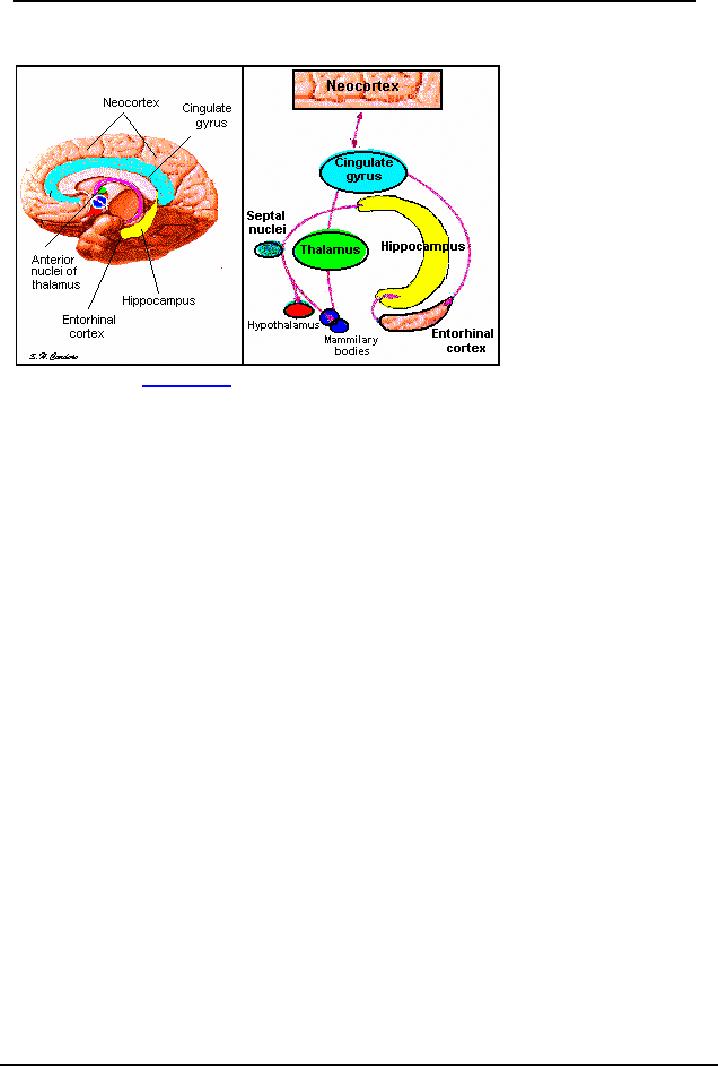 |

Neurological
Basis of Behavior (PSY -
610)
VU
Lesson28
Basic
Neuroanatomy
Objectives:
The
main objective of this lesson is to study
·
The
Brain and the Peripheral systems:
·
Brain:
Forebrain, Mid brain, Hind Brain functioning of each anatomical location in the
CNS.
Starting
from the posterior located areas upto the anterior-most.
·
Cerebral
Cortex: its layers, Corpus Callosum and the two hemispheres
Main
purpose:
Students
will become familiarized
with the location of various
brain areas, their functions
and their
relationship
to other areas. The students
would also understand how
control and modulation of
behaviour
related to each neuroanatomical site
takes place
In
lesson 27 we discussed some
parts of the Mesencephalon, and now we
continue with the
remaining
areas
which fall under
Mesencephalon.
·
Tegmentum:
This
lies between the Tectum and Substantia
Nigra. It contains nuclei and relay
fibres
of
ascending and descending tracts. It also
contains the motor cranial nerves
for eye movements
(oculomotor)
and the trochlear cranial
nerves. The three major
fibre bundles are the Medial
Leminiscus
(
ML)and the Trigeminal
Leminiscus (TL) and the
Spino-thalamic
tract (
STT)
·
The
ML
lies
above the Substantia
Nigra (SN) and
conveys kinesthetic and discriminative
touch
sensory
information to the Thalamus.
·
The
TL
also
are tracts which travel
upto the Thalamus
·
The
STT
conveys
the pain and temperature sensations
from the contralateral hemisphere (
e.g from
the
left arm to the right side
of the brain).
·
PAG:
Peri-Aquaductal Gray. This is the
grey matter which surrounds the cerebral
aquaduct: This
has
the neural circuitry for
sequence of movements for
species specific behaviors
(fight, flight, and
mating).
Research ahs also shown this
to be an important area for
pain sensations. If opiates
are
injected
in this area they reduce the
sensitivity to pain ( raise the tolerance
threshold)
·
In
the basal portion of tegmentum we have the cerebral
peduncles which are large
fibre bundles
which
are placed in the ventral region of the
mesencephalon. These carry
fibres of the
cortico-
spinal
tract, and the
cortico-pontine
tract. There
are also large projections
such as the pareito-
occipito-tempero-pontine
projections
which carry projection from
cerebral cortex down
through
pontine
area into the spinal
cord.
·
Substantia
Nigra: dark pigmented mass of
neurons, between cerebral peduncles and tegmentum,
zona
compacta rich in Dopamine and brain opiate receptors. This is part of the brains
motor control
and
modulation sys tem, and is involved in movement and balance. If we create an
imbalance in the
bilaterally
located SN areas by a unilateral lesion, we see asymmetric body posture. The
bdoy turns
from
the high to the low region (lopsided posture). If the Dopamienrgic neurons
degenerate in this
area
it leads to Parkinson's disease. This is characterized by tremor rigidity,
slowness of motor
activity,
stiffness in muscles, pin rolling movement, loss of adaptation (facial
expression and gait).
Inputs
come from the Neostriatum, cerebral cortex, Globus Pallidus, and other parts of
the
Tegmentum
98

Neurological
Basis of Behavior (PSY -
610)
VU
·
Red
Nucleus: neurons with a pinkish
hue are an important is importna area in Tegmentum. Inputs
come
in from deep cerebellar nuclei and the cerebral motor cortex. If the deep
cerebellar input is
damaged,
tremor is manifested when the hand or foot is in motion (reaching out). The
gross
movements
of body are controlled by this system. If there is unilateral electrical
stimulation, it leads
to
circulatory motion, and lesions result in disturbances of gait
(walking).
The
Medulla, Pons, and the lower areas had evolved earlier on the revolutionary
scale and are similar
from
fish to man. The fish don't have a cerebral cortex, but have large inferior and
superior colliculi, as
this
is what fishes would need for determining direction while swimming in water.
Bats are nocturnal
creatures
which fly and hunt at night. For bats audition becomes more important for
survival more than
vision,
therefore the bats have bigger inferior than superior coliculli. The brain stem
areas serves as a
connection
between upper and lower areas, that is they connect the Telencephalon and
Diencephalon to
the
Spinal Cord
MID
BRAIN areas: These comprise of the
Corpus
Striatum: Striated bodies( corpus)
This group of
structures
includes the Basal Ganglia the Caudate ( Tail Like) Nucleus,
Globus Pallidus ( Pale Globe),
Putamen
. These
areas lie underneath the cerebral cortex
The
Corpus Striatum receives input from and
sends output to the cerebral cortices, especially the
frontal
areas where the motor lobe is located. They also send fibres to the Thalamus
(output). There are
numerous
interconnections between different areas of the corpus striatum. These areas
appear to be
involved
in the modulation of motor movement, especially the movement/modulation of
contralateral
aspect
of the body. This also has the controls of initiation of movement, contralateral
head turning,
circling,
licking, chewing, gnawing etc. This is also important part of the Dopaminergic
pathway
involved
in Parkinson's disease. Bilateral lesions of pallidus lead to hypoactive and
sleepy animal.
Thus,
this appears to be the basis of decreased movement and hypokinesia of
Parkinsons' disease. On
the
hand, the Caudate promotes arousal of motor system. So they balance the controls
of motor
movement.
·
If
we look at the hierarchy of movement starting from the highest control, the
cerebral cortex, we
see
that the Motor cortex-sends commands to the striatum, from there the commands go
through the
nigral
system and then the action takes place. As motor skills are learned the basal
ganglia takes
over
role of executing learned strategy. So the commands go from the striatum to the
nigral for
preparation
of action to take place. This becomes more automated and programmed. Think
about
how
a child learns to walk, slow deliberate balancing takes place initially and then
gradually
locomotion
becomes a routine. However, when basal ganglia are damaged the individual
reverts to
slower
less automatic cortical response. Basically the preparation of execution of
movement is the
main
function: We could call it a Gating
function: This means gating of
sensori-motor processing
(controlling
the gates of channels which provide information). Thus, it limits the access
of
information
to motor systems.
·
Huntington's
chorea is due to degeneration of Basal ganglia. This degeneration
results in
reduction
of inhibitory output of BG- which leads to increased access of sensory
information, which
leads
to increased activity (hyperkinesis, sudden jerks, tics, and jerky movements of
head, trunk and
extremities,
facial grimaces, repetitive dancing movement.
·
On
the other hand in Parkinson's disease, there is decreased Dopaminergic input
which inhibits
action
in Basal Ganglia. As you have seen earlier, if the basal ganglia is not working
the cortex
would
take over. Therefore the reduced Dopamine in Basal Ganglia then allows cortical
areas to
stimulate
the motor system. There is an increased inhibition of inhibitory BG output,
(stimulates the
inhibitory
hypokinesia). The damage to Basal Ganglia also results in deficits in Cognitive
functions
such
as deficits in spatial memory, and inability to switch to appropriate
behaviour.
99

Neurological
Basis of Behavior (PSY -
610)
VU
Limbic
system
Limbic
system: ref www.healing
arts.
Org/n-r-limbic.htm
·
Limbic
system: It borders the Telencephalon, and Diencephalon, in appearance looks like
a ring
around
the Thalamus.It was first described by Broca in 1878. This is also known as the
Circuit of
Papez,
as Papez (1937) first identified it as a reverbrating circuitry which was
important in
emotions.
Limbic areas are spread into parts of the Frontal, Parietal and Temporal lobes.
Therefore
it
appears to have diverse connections and functions. These are mainly emotions but
also memory,
homeostatic
and survival functions (fight, flight, feed, and mating). The areas which are
part of the
limbic
system are: Cingulate
Gyrus, Septal Nuclei, Hippocampus, Amygdala,
Hypothalamus,
Anterior
Thalamus, Mammilliary Bodies
·
Hippocampus
like
a sea horse lesion- is important in th eforamtion of memeories especially
long
term.
If lesioned bilaterally there is damage to learned emotional response and memory
is severly
affected
(both recent and long term). Hippocampus is thus involved in Emotions,
memory,
homeostatic
responses fight/flight, motivational states
·
Fornix:
This
is a large fibre bundle shaped in the form of an arch which connects the
hippocampal
formation
to subcortical areas such as thalamus, hypothalamus, and septum. It runs
directly under
the
runs under the corpus callosum( bands of fibres which connect the two
lobes)
·
Amgdala:
(almonds:
greek) major part limbic system: lcoated at the tip of temporal lobe
beneath
the
cortex and rostrally to hippocampus. Have connections with hippocampus, septum,
emdaildorsal
thalamus
and the prefrontal areas. It is because of these connections that the amygdale
is important
in
emotional responses love, friendship fear, and rage aggression. This is involved
in physiological
response
of emotions: heart rate pulse etc. orienting to novel stimuli, déjà vu. If
stimulated of
olfactory
and gustatory hallucination (temporal lobe epilepsy). Bilateral lesions of
amygdalas lead
to
the Kluver-Bucy syndrome: hyperorailty, hypersexuality (animate or inanimate
objects) docility,
learned
fears (and agression) such as fear of snakes gone as the animals put snakes in
their mouth.
This
accompanied by lack of affect, apathy and blunted expression. This syndrome was
first
described
by Kluver Bucy in 1939 after bilateral lesions in monkeys
·
On
the other hand electrical stimulation of AMygdala lead to a rage reaction the
amygdale involved
in
identification of danger therefore is important for self preservation. When
triggered, it gives rise
to
fear and anxiety which lead the animal into a stage of alertness, getting ready
to flight or fight.
100

Neurological
Basis of Behavior (PSY -
610)
VU
·
Septum:
lesion
in the septum leads to intense rage reaction (called the Septal Rage) as
does
stimulation
of the amygdale. Septum leads to increased activity in a novel situation,
increase reward
feeling
with stimulation. This also plays am important role in motivational states such
as feeding
and
drinking etc.
Cingulate
Gyrus: ( Cingulate:
encircling) located between the cingulate
sulcus and the corpus
callosum
The
anterior area gives rise to
déjà vu that is smells and
sights with pleasant
memories of previous
emotions.,
also important role in
emotional reaction to pain and
agression cingulectomy tames
unruly
and
wild animals. If a single bundle of
this gyrus is cut (cingulotomy) it
interrupts the limbic
areas
communicationswith
each other (reverbratiung
circuitry affected) thus
leading to reduced
depression
and
anxiety levels (which preexisted in the
patients). (Points to ponder-
looks like a good option
for
treatment--but
who is to decide?)
Refernces
1.
Carlson N.R. (2005) Foundations of
Physiological Psychology Allyn and Bacon,
Boston
2.
Pinel, John P.J. (2003)
Biopsychology (5th edition) Allyn and Bacon
Singapore
3.
Bloom F, Nelson and Lazerson (2001),
Behavioral Neuroscience: Brain, Mind and
Behaviors (3rd
edition)
Worth Publishers New
York
4.
Bridgeman, B (1988) The
Biology of Behaviour and Mind. John
Wiley and Sons New
York
5.
Brown,T.S. and Wallace.(1980) P.M
Physiological Psychology
Academic
Press New York
Note:
References
1, 2, 3, 5 more closely followed in
addition to the references cited in
text.
101
Table of Contents:
- INTRODUCTION:Descriptive, Experimental and/ or Natural Studies
- BRIEF HISTORICAL REVIEW:Roots of Behavioural Neurosciences
- SUB-SPECIALIZATIONS WITHIN THE BEHAVIORAL NEUROSCIENCES
- RESEARCH IN BEHAVIOURAL NEUROSCIENCES:Animal Subjects, Experimental Method
- EVOLUTIONARY AND GENETIC BASIS OF BEHAVIOUR:Species specific
- EVOLUTIONARY AND GENETIC BASIS OF BEHAVIOUR:Decent With Modification
- EVOLUTIONARY AND GENETIC BASIS OF BEHAVIOUR:Stereoscopic vision
- GENES AND EXPERIENCE:Fixed Pattern, Proteins, Genotype, Phenotypic
- GENES AND EXPERIENCE:Mendelian Genetics, DNA, Sex Influenced Traits
- GENES AND EXPERIENCE:Genetic Basis of behavior, In breeding
- GENES AND EXPERIENCE:Hybrid vigor, Chromosomal Abnormalities
- GENES AND EXPERIENCE:Behavioral Characteristics, Alcoholism
- RESEARCH METHODS AND TECHNIQUES OF ASSESSMENT OF BRAIN FUNCTION
- RESEARCH METHODS AND TECHNIQUES OF ASSESSMENT OF BRAIN FUNCTION:Activating brain
- RESEARCH METHODS AND TECHNIQUES OF ASSESSMENT OF BRAIN FUNCTION:Macro electrodes
- RESEARCH METHODS AND TECHNIQUES OF ASSESSMENT OF BRAIN FUNCTION:Water Mazes.
- DEVELOPMENT OF THE NERVOUS SYSTEM:Operation Head Start
- DEVELOPMENT OF THE NERVOUS SYSTEM:Teratology studies, Aristotle
- DEVELOPMENT OF THE NERVOUS SYSTEM:Stages of development, Neurulation
- DEVELOPMENT OF THE NERVOUS SYSTEM:Cell competition, Synaptic Rearrangement
- DEVELOPMENT OF THE NERVOUS SYSTEM:The issues still remain
- DEVELOPMENT OF THE NERVOUS SYSTEM:Post natal
- DEVELOPMENT OF THE NERVOUS SYSTEM:Oxygen level
- Basic Neuroanatomy:Brain and spinal cord, Glial cells, Oligodendrocytes
- Basic Neuroanatomy:Neuron Structure, Cell Soma, Cytoplasm, Nucleolus
- Basic Neuroanatomy:Control of molecules, Electrical charges, Proximal-distal
- Basic Neuroanatomy:Telencephalon, Mesencephalon. Myelencephalon
- Basic Neuroanatomy:Tegmentum, Substantia Nigra, MID BRAIN areas
- Basic Neuroanatomy:Diencephalon, Hypothalmus, Telencephalon, Frontal Lobe
- Basic Neurochemistry:Neurochemicals, Neuromodulator, Synaptic cleft
- Basic Neurochemistry:Changes in ionic gates, The direct method, Methods of Locating NT
- Basic Neurochemistry:Major Neurotransmitters, Mesolimbic, Metabolic degradation
- Basic Neurochemistry:Norepinephrine/ Noradrenaline, NA synthesis, Noadrenergic Pathways
- Basic Neurochemistry:NA and Feeding, NE and self stimulation: ICS
- Basic Neurochemistry:5HT and Behaviors, Serotonin and sleep, Other behaviours
- Basic Neurochemistry:ACH and Behaviors, Arousal, Drinking, Sham rage and attack
- Brain and Motivational States:Homeostasis, Temperature Regulation, Ectotherms
- Brain and Motivational States:Biological Rhythms, Circadian rhythms, Hunger/Feeding
- Brain and Motivational States:Gastric factors, Lipostatic theory, Neural Control of feeding
- Brain and Motivational States:Resting metabolic state, Individual differences
- Brain and Motivational States:Sleep and Dreams, Characteristics of sleep
- Higher Order Brain functions:Brain correlates, Language, Speech Comprehension
- Higher Order Brain functions:Aphasia and Dyslexia, Aphasias related to speech
- Higher Order Brain Functions:Principle of Mass Action, Long-term memory
- Higher Order Brain Functions:Brain correlates, Handedness, Frontal lobe